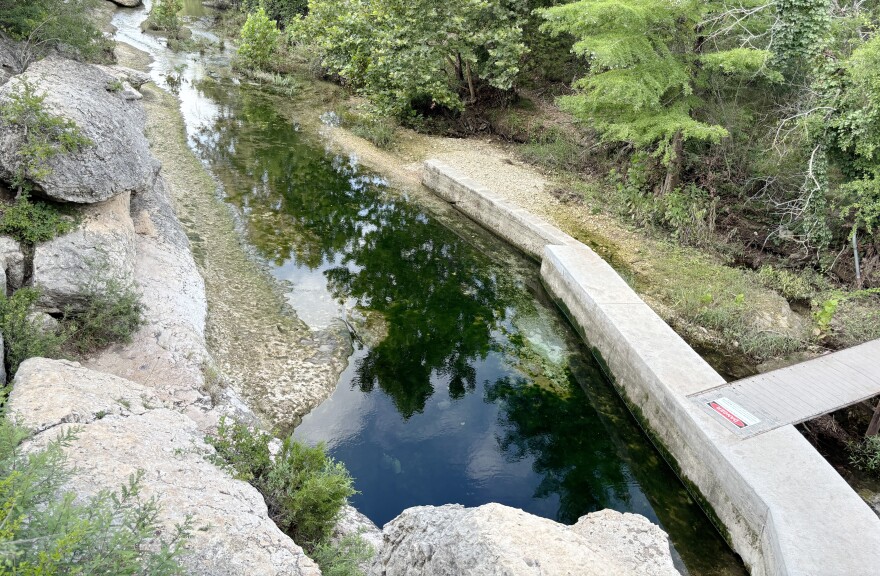Jacob’s Well, the spring-fed swimming hole in Wimberley, filled with water this month in a way park staff said they have not seen in years.
Heavy rain and flooding in the Central Texas region over the July Fourth weekend have caused water to rush out of the deep, blue hole — a sight that has become more and more uncommon.
Data from the United States Geological Survey shows Jacob's Well has been doing well this summer. Water levels haven't been this high since May of 2022.
“There definitely is some hope in the air,” Katherine Sturdivant, the Hays County Parks Department education coordinator, said. “ The question has shifted from, ‘Will it ever flow again?’ to ‘If and when it does start again, what are we gonna do?'”
Monitoring the well
This summer marks the fourth in a row that Jacob’s Well is closed for swimming. David Baker, executive director of The Watershed Association, said long-time Austinites and people who live in the area are fond of Jacob's Well and want to see it return as a community hub to swim in.
"It's sort of like monitoring our beloved grandmother's condition, like 'How's she doing now?'" he said. "It's an intimate relationship, people love that place."
Although Central Texas has a history of drought and is currently experiencing a years-long one, Baker said Jacob’s Well does not have a history of low flow.
About 55% of the water used in Texas comes from aquifers, and these natural underground reservoirs are not easily replenished.
Jacob's Well gets its water from the Trinity Aquifer. But with less water going into the aquifer and more coming out to address the needs of a growing population, Jacob’s Well has struggled to maintain water levels high enough to swim in.
" It's kinda like a bank account that you've overdrawn, but you keep spending and you're not depositing anything into it," Baker said. "So that rain has to fall more consistently."
In 2021, Jacob’s Well stopped flowing for only the fourth time in recorded history. It lasted for a couple of days, and the flow rate stayed dangerously low for months. Then, the flow stopped for a fifth time in 2022. It happened a sixth time in 2023.
After that sixth time, it never fully recovered. Sturdivant said she doesn’t track the water flow like that anymore.
“Over the years, it’s gone from this very new thing to a kind of new normal,” she said. “We kind of measured it in days, now it’s just been years. It’s really interesting how the language of talking about it has changed.”
Not everyone is cautiously optimistic
Sturdivant and members of the Hays County Parks staff are feeling optimistic about the swimming hole one day opening back up for swimming.
The rain that fell in Central Texas earlier this month didn’t fall over Jacob’s Well. Instead, it fell over a much more crucial area: The aquifer’s recharge zone.
As rain falls over these areas, it trickles down through caves, sinkholes and cracks. These "recharge" zones filter and fill water underground.
Sturdivant said the rain from the July 4 floods didn't just refill Jacob's Well; it added some water back to the source, the Trinity Aquifer.
“There’s actually some groundwater recharge and not just that pulse of rain that moves through the system so quick,” Sturdivant said. “ I definitely feel a huge, huge relief seeing all of this rain actually increasing flow in a meaningful way.”
But Baker doesn't quite share that cup-half-full optimism. The water levels and flow rates at Jacob's Well have already started trending down since the rain earlier this month, according to data from the USGS.
Baker said the aquifer will need much more rain passing through its recharge zone to make a long-lasting change at Jacob's Well.
" We're adding more wells and adding more extraction," he said. "And then you have [companies] that don't follow the drought contingencies when they're supposed to cut back."
Baker said it will take a combination of consistent rain each month and water conservation to bring the aquifer fully back to life.
Correction: This story has been updated to reflect Jacob's Well recorded water levels this month that have not been seen since 2022.





